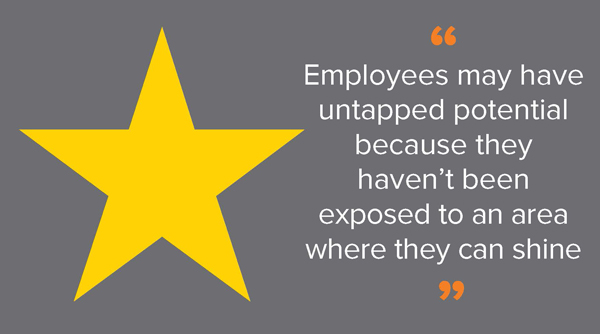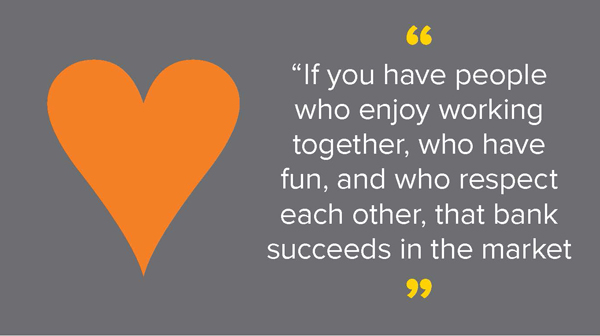Star search success
Human capital is key. Large and small banks share their best practices
- |
- Written by Melanie Scarborough

Talent is a defining characteristic of banks that will be able to thrive and survive,” says Alan Kaplan, who should know. He began his career 31 years ago as a banker before founding Kaplan Partners, an executive search and talent advisory firm headquartered in Philadelphia that helps banks recruit top-level employees—an increasingly difficult task. “Although there are fewer banks now, the number of people qualified to lead them or take senior roles has not kept pace with the demand. Everyone in banking is going after a finite number of quality people,” says Kaplan.
So how can you find, recruit, and retain the best employees for your bank? It turns out that good workers are like financial assets: The more you have, the more you are likely to obtain.
“Talent begets talent,” says Jim Cherry, CEO of Park Sterling Bank, headquartered in Charlotte, N.C. In 2010, Cherry, retired from Wachovia Bank, put together a team for a new regional community bank. Cherry’s first recruit was CFO David Gaines, who also had been at Wachovia. “The two of us worked together to recruit others, and pretty soon we had a management team and a board of directors,” says Cherry. Ultimately, Cherry’s group approached Park Sterling, and that bank agreed to hire Cherry’s management team to supplement its own, and reconstitute its board with Cherry’s board members. This has paid off. Since 2010, the bank has grown from 47 employees in three offices and $480 million in assets to 500 employees in 53 offices and assets of $2.4 billion.
Park Sterling hires only within its market and draws people from other banks. “This is where the ‘talent begets talent’ comes in,” Cherry explains. “When we’re trying to recruit someone, we bring have them meet with our team. They leave saying, ‘Gee, I’d love to work with these people.’”
The potential downside to hiring from other banks is that poaching can spur poaching. To keep a good team on board, banks have to make sure that employees are empowered and engaged. “Everybody wants to make more money, but high-potential people are motivated by the ability to have an impact,” says Kaplan. “An employee who’s being recognized, rewarded, stretched, and challenged won’t be so eager to leave. If they’re being paid well, but the environment isn’t challenging, the organization may still lose them.”
Once you have them, keep them
It’s important not to micromanage talented leaders, says Cherry, and to empower front-line employees so they “can sit down in front of a customer and say, ‘Here’s how we can make this happen,’ instead of just gathering information. It makes people feel valued when you empower them to do business.”
WSFS Bank, a $5.1 billion-asset institution based in Wilmington, Del., ranked as the third-best large employer in a local survey last year. Since 2003, the bank has worked with Gallup to measure employee engagement and learn where it can improve, says Peggy Eddens, executive vice-president and chief human capital officer. “If employees are engaged, they’re more committed to what they’re doing. They serve at a higher level.”
Staff loyalty can be cemented in unexpected ways, such as the Toastmaster chapter WSFS hosts. “This group that works together becomes friends,” says Eddens. “After the chapter moves on, they retain connections in the company that make them more connected to each other—and that connection is WSFS.”
The Virginia Division of SunTrust Bank asks for employee feedback and acts on concerns. “Last year, teammates were concerned about their health and well being, so we developed a program that makes health a priority,” says Division President and CEO John Stallings. The bank also has a financial fitness program for employees and their families. One of his expectations of managers is that they will spend a lot of time coaching their staffs and helping them navigate the next steps in their careers. “For me, it comes down to leadership and teamwork,” Stallings says, “helping create engaged teammates who want to spend their entire careers at SunTrust.”
Talent in your own back yard
Many banks cultivate home-grown talent by grooming employees within the bank. A couple years ago, Northwest Financial Corp., a $1.6 billion-assets bank in Arnolds Park, Iowa, began a succession planning process for 53 of it 425 employees. Alex Oponski, chief people officer, met with those employees, their supervisors, and the CEO to discuss who could replace them if they were promoted (or retired) and whether their potential successors were prepared. And if not, what should be done to prepare them? The answer to the latter, says Oponski, could be sending someone to a graduate school of banking or exposing them to a process they need to be familiar with.”
Northwest Financial also identified about 50 other employees who weren’t part of the immediate succession plan, but viewed as rising stars. “We’re developing a class that will work on specific projects to see if they’re truly visionary,” says Oponski. Neal and Dwight Conover, the two brothers who own the bank, serve as mentors to this group. “You have to have a plan to keep the organization vibrant and have new leaders come up through the bank,” Oponski says. “A lot of banks don’t have that and will have to sell” when their leaders are gone.
Employees may have untapped potential because they haven’t been exposed to an area where they can shine. WSFS has a program where associates form teams and decide what banking operation they want to learn more about. “One wanted to learn about private banking, so we took a trip to Greenville where that office is,” says Eddens. “That’s been very successful. We’ve had people apply for positions they never knew they were interested in until they saw how it worked.”
The obvious—if you want good employees, train them—sometimes is not so obvious. Oponski says when times are lean, banks often cut training programs. “Our owners would say bad times are the exact times you should be training.”
WSFS has a self-designed leadership program in which 30 associates, mostly first-level managers, study 16 modules over an 18-month period. The bank also has a rotational leadership program that allows mid-level managers to trade chairs for six months to a year. They learn what other jobs are like and bring a fresh perspective to a job that may benefit from a different set of eyes.
SunTrust has a wholesale analyst program available to about 30 recent college graduates when they join the bank. “We found a real interest level because it allows for on-the-job training and, ultimately, a placement on our wholesale team—a highly sought-after role with the bank,” says Stallings.

Think outside the bank
If your bank is good at training, you can tap a wider pool of potential hires outside the industry. Northwest Financial has drawn people from retail stores like Walmart. “So many bank jobs involve selling, so drawing from retail is good,” says Oponski. Because some of its Iowa markets are heavily agricultural, the bank also looks at co-ops for prospective employees. “If someone’s not afraid to make cold calls or is good at selling, we can train them in banking,” he says.
In fact, hiring from outside the industry can be preferable. “It might be better to take on someone who hasn’t been in banking and teach them our style, rather than retrain someone who has grown up in another organization,” Oponski notes.
Sandy Crawford came to Tioga State Bank from a career as a farmer. After her husband’s death in 2001, she kept the family farm going with the help of her four daughters and her work with Farm Credit in Pennsylvania. “We lured her away from there to come work for us,” says Robert Fisher, president and CEO of the $420 million-assets bank based in Spencer, N.Y. Crawford specializes in agricultural lending, where she brings first-hand knowledge of customer needs.
One of Tioga State Bank’s goals is to be a local employer of choice, and it must be succeeding, because Fisher says a lot of his new hires come through referrals from employees. When people enjoy where they work, they recommend it.
Northwest Financial advertises jobs in Hispanic newspapers to try to bring minorities into its workforce. Section 342 of Dodd-Frank compels financial institutions to more fully utilize women and minorities, but that isn’t the only reason the bank seeks diversity in its staff. Oponski says some immigrant cultures seem mistrustful of banks, “but if you hire someone who speaks their language, who lives in their community, you overcome that problem.”
Drawing a young crowd
Another cohort accused of being wary of banks is the millennial generation, yet the bankers interviewed say their experience does not reflect it. “In Iowa, coming from a small-town background, young people understand the value of banking,” says Oponski. “They know how important it is to the agricultural community.”
Even a megabank, such as $122 billion-asset Regions Bank, has not discerned any hostility—indeed, quite the contrary. Its Management Associate Program, which accepts about 40 recent college graduates each year, had almost 1,500 applicants in 2014. Jonathon Studstill, vice-president, program manager, says banking is a good career fit for the youngest workers. “Millennials love the complexity of this type of industry,” he says; plus, the bank’s culture appeals to them. “Regions’ goal is to make an impact in communities, and millennials love making an impact.”
Stallings is seeing the same thing at SunTrust, where there are more applicants than job openings for entry-level positions. He believes banking retains its appeal because it’s a profession that offers a future. “When you recruit a young person coming out of college, they’re interested not just in the job, but in a career path,” he says.
Banking’s increasing reliance on technology also is attractive to many in the younger set. “Banking is obviously changing pretty dramatically,” Tioga State Bank’s Fisher says. “The IT side of the shop is where young people have more of an interest.” Cherry finds that to be true at Park Sterling, which has used technologies, such as remote capture, since the bank’s inception in 2006. “People feel like we’re on the leading edge of what’s going on in banking,” he says.
Technology seems to have limited use in finding potential hires, however. Although experiences vary, many bankers say they have not found Facebook and Twitter particularly effective. LinkedIn can be helpful, Kaplan says, particularly for mid-level employees. But the old standby, college fairs, seems to remain the most productive recruitment venue.

Bankers’ hiring tips
Regardless of where you look for talent, you have to be able to know it when you see it. Communication skills, an outgoing nature, and teamwork are basics, but other qualities can be telling as well. For Regions’ Studstill, “the secret sauce” of a good employee is someone who understands that change is constant. “No one is going to stay the same throughout their career, so the ability to learn and grow is something we try to identify,” he says. “The banking environment is going to change, particularly the regulatory environment, and those who thrive are those who can adjust.”
Tioga State Bank’s Fisher looks for candidates who have the capacity to listen, because that’s someone who will focus on a customer’s needs. Northwest Financial does a lot of testing, but does not rely solely on the results. “If the job requires detail, but the predictive index shows the candidate has a low capacity for that, then maybe I have a disconnect,” says Oponski. “But if I like what I see, I ask more questions.”
Oponski advises managers never to settle for hiring a warm body, even when a department is short-handed and losing money on overtime. “It’s better to wait for the right candidate than to hire for the same position three times,” he says.
When scouting for leadership potential within WSFS Bank, Eddens and CEO Mark Turner take cues from an employee’s office. The kind of photos or other displays a person has can tell a lot about what the person considers important, says Eddens.
It’s also possible to hire a good employee, but not utilize them correctly, which is why Regions Bank asks prospects not “What role do you want?” but “What do you enjoy doing?” Susan Hengel, executive vice-president of organizational effectiveness, says that approach is more likely to create a good match between the employee’s aspirations and the bank’s needs.
Such unions serve banks well. “If you have people who enjoy working together, who have fun, and who respect each other, that bank succeeds in the market, because one of the things that plays into is low turnover, which the community views as stability,” says Oponski. “The better the team, the more the success.”
This article originally appeared in the October-November 2015 Banking Exchange magazine. To read the article in magazine form, click here.
Subscribe to Banking Exchange magazine
Tagged under Human Resources, Management, HowTo, Community Banking, Feature, Feature3,














